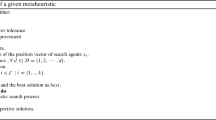Abstract
In this paper, a new hybrid algorithm is introduced, combining two Harris Hawks Optimizer (HHO) and the Imperialist Competitive Algorithm (ICA) to achieve a better search strategy. HHO is a new population-based, nature-inspired optimization algorithm that mimics Harris Hawks cooperative behavior and chasing style in nature called surprise pounce HHO. It is a robust algorithm in exploitation, but has an unfavorable performance in exploring the search space, while ICA has a better performance in exploration; thus, combining these two algorithms produces an effective hybrid algorithm. The hybrid algorithm is called Imperialist Competitive Harris Hawks Optimization (ICHHO). The proposed hybrid algorithm's effectiveness is examined by comparing other nature-inspired techniques, 23 mathematical benchmark problems, and several well-known structural engineering problems. The results successfully indicate the proposed hybrid algorithm's competitive performance compared to HHO, ICA, and some other well-established algorithms.





















Similar content being viewed by others
References
Faris H, Ala’M AZ, Heidari AA, Aljarah I, Mafarja M, Hassonah MA, Fujita H (2019) An intelligent system for spam detection and identification of the most relevant features based on evolutionary random weight networks. Information Fusion 48:67–83
Wu G (2016) Across neighborhood search for numerical optimization. Inf Sci 329:597–618
Kaveh A, Dadras Eslamlou A (2020) Metaheuristic optimization algorithms in civil engineering: new applications. Springer, Switzerland
Dréo J, Pétrowski A, Siarry P, Taillard E (2006) Metaheuristics for hard optimization: methods and case studies. Springer Science and Business Media, p 369
Talbi E-G (2009) Metaheuristics: from design to implementation. John Wiley and Sons 74
Kirkpatrick S, Gelatt CD, Vecchi MP (1983) Optimization by simulated annealing. Science 220(4598):671–680
Luo J, Chen H, Xu Y, Huang H, Zhao X (2018) An improved grasshopper optimization algorithm with application to financial stress prediction. Appl Math Model 64:654–668. https://doi.org/10.1016/j.apm.2018.07.044
Shen L, Chen H, Yu Z, Kang W, Zhang B, Li H, Yang B, Liu D (2016) Evolving support vector machines using fruit fly optimization for medical data classification. Knowl-Based Syst 96:61–75. https://doi.org/10.1016/j.knosys.2016.01.002
Mirjalili S, Lewis A (2016) The whale optimization algorithm. Adv Eng Softw 95:51–67. https://doi.org/10.1016/j.advengsoft.2016.01.008
Holland JH (1992) Genetic algorithms. Sci Am 267(1):66–73
Storn R, Price K (1997) Differential evolution: a simple and efficient heuristic for global optimization over continuous spaces. J Global Optim 11(4):341–359. https://doi.org/10.1023/A:1008202821328
Kennedy J, Eberhart R (1995) Particle swarm optimization In: Proceedings of ICNN'95: international conference on neural networks, 27 Nov.-1 Dec. 1995 1995 1942–1948, 1944
Dorigo M, Maniezzo V, Colorni A (1996) Ant system: optimization by a colony of cooperating agents. IEEE Transactions Syst Man Cyber Part B (Cybernetics) 26(1):29–41. https://doi.org/10.1109/3477.484436
Kaveh A, Dadras Eslamlou A (2020) Water strider algorithm: a new metaheuristic and applications. In: Structures. Elsevier, 520–541
Cuevas E, Fausto F, González A (2020) A swarm algorithm inspired by the collective animal behavior. In: Cuevas E, Fausto F, González A (eds) New advancements in swarm algorithms: operators and applications. Springer International Publishing, Cham, pp 161–188
Tahani M, Babayan N (2019) Flow regime algorithm (FRA): a physics-based meta-heuristics algorithm. Knowl Inf Syst 60(2):1001–1038. https://doi.org/10.1007/s10115-018-1253-3
Hashim FA, Houssein EH, Mabrouk MS, Al-Atabany W, Mirjalili S (2019) Henry gas solubility optimization: a novel physics-based algorithm. Future Gen Comp Syst 101:646–667. https://doi.org/10.1016/j.future.2019.07.015
Sadollah A, Bahreininejad A, Eskandar H, Hamdi M (2013) Mine blast algorithm: a new population based algorithm for solving constrained engineering optimization problems. Appl Soft Comput 13(5):2592–2612. https://doi.org/10.1016/j.asoc.2012.11.026
Glover F (1989) Tabu search—part I. ORSA J Comput 1(3):190–206. https://doi.org/10.1287/ijoc.1.3.190
Kumar M, Kulkarni AJ, Satapathy SC (2018) Socio evolution and learning optimization algorithm: a socio-inspired optimization methodology. Future Gen Comp Syst 81:252–272. https://doi.org/10.1016/j.future.2017.10.052
Atashpaz-Gargari E, Lucas C (2007) Imperialist competitive algorithm: an algorithm for optimization inspired by imperialistic competition. In: 2007 IEEE congress on evolutionary computation, pp. 4661–4667. IEEE.
Ting T, Yang X-S, Cheng S, Huang K (2015) Hybrid metaheuristic algorithms: past, present, and future. In: Recent advances in swarm intelligence and evolutionary computation. Springer, pp. 71–83
Talbi E-G (2002) A taxonomy of hybrid metaheuristics. J Heurist 8(5):541–564. https://doi.org/10.1023/A:1016540724870
Heidari AA, Mirjalili S, Faris H, Aljarah I, Mafarja M, Chen H (2019) Harris Hawks optimization: algorithm and applications. Future Gen Comp Syst 97:849–872. https://doi.org/10.1016/j.future.2019.02.028
Sadollah A, Sayyaadi H, Yadav A (2018) A dynamic metaheuristic optimization model inspired by biological nervous systems: Neural network algorithm. Appl Soft Comput 71:747–782. https://doi.org/10.1016/j.asoc.2018.07.039
Gümüş DB, Özcan E, Atkin J (2016) An Analysis of the Taguchi Method for Tuning a Memetic Algorithm with Reduced Computational Time Budget. In, Cham Computer and Information Sciences. Springer International Publishing, pp. 12–20
Hussain K, Salleh MNM, Cheng S, Shi Y (2019) On the exploration and exploitation in popular swarm-based metaheuristic algorithms. Neural Comput Appl 31(11):7665–7683. https://doi.org/10.1007/s00521-018-3592-0
Lee KS, Geem ZW (2004) A new structural optimization method based on the harmony search algorithm. Comput Struct 82(9–10):781–798. https://doi.org/10.1016/j.compstruc.2004.01.002
Li L, Huang Z, Liu F, Wu Q (2007) A heuristic particle swarm optimizer for optimization of pin connected structures. Comput Struct 85(7–8):340–349. https://doi.org/10.1016/j.compstruc.2006.11.020
Kaveh A, Talatahari S (2009) Particle swarm optimizer, ant colony strategy and harmony search scheme hybridized for optimization of truss structures. Comput Struct 87(5–6):267–283. https://doi.org/10.1016/j.compstruc.2009.01.003
Kaveh A, Ilchi Ghazaan M (2015) A comparative study of CBO and ECBO for optimal design of skeletal structures. Comput Struct 153:137–147. https://doi.org/10.1016/j.compstruc.2015.02.028
Kaveh A, Bakhshpoori T (2016) An accelerated water evaporation optimization formulation for discrete optimization of skeletal structures. Comput Struct 177:218–228. https://doi.org/10.1016/j.compstruc.2016.08.006
Kaveh A, Mahdavi VR (2014) Colliding bodies optimization: a novel meta-heuristic method. Comput Struct 139:18–27. https://doi.org/10.1016/j.compstruc.2014.04.005
Kaveh A, Moradveisi M (2016) Optimal design of double-layer barrel vaults using CBO and ECBO algorithms. Iran J Sci Technol Transactions Civil Eng 40(3):167–178. https://doi.org/10.1007/s40996-016-0021-4
Author information
Authors and Affiliations
Corresponding author
Ethics declarations
Conflict of interest
No potential conflict of interest was reported by the authors.
Additional information
Publisher's Note
Springer Nature remains neutral with regard to jurisdictional claims in published maps and institutional affiliations.
Rights and permissions
About this article
Cite this article
Kaveh, A., Rahmani, P. & Eslamlou, A.D. An efficient hybrid approach based on Harris Hawks optimization and imperialist competitive algorithm for structural optimization. Engineering with Computers 38 (Suppl 2), 1555–1583 (2022). https://doi.org/10.1007/s00366-020-01258-7
Received:
Accepted:
Published:
Issue Date:
DOI: https://doi.org/10.1007/s00366-020-01258-7




